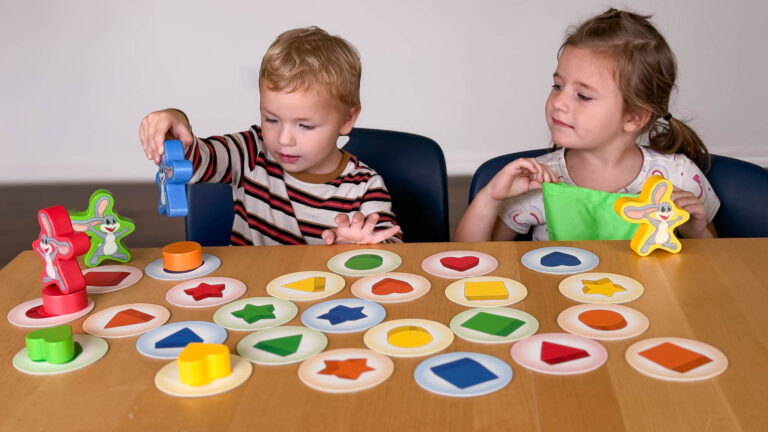*Updated to include Azul: Queen’s Garden* Azul is one of the most popular modern board games of the last 5 years. Azul, once a title for a single game, has since become the name of a series. With four stand alone games that each sound and look similar, you might be wondering which game is right for you.
We’ve played all four and we can confirm that each are perfectly lovely in their own way. Yet, because they are each so similar to the other, we don’t feel that you need to have each game on your shelf.
But which one should you get? Which is the right fit for you?
We’re here to help match you with your perfect Azul gaming experience.

What exactly is Azul?
If you haven’t played Azul, you may be wondering what exactly you’ll do in these games.
While each game is slightly different, the general idea is the same.
In the Azul game series, players will take turns drafting colored tiles from the center circles to their player board. When certain sets of tiles are collected and satisfy placement requirements on their board players are able to score points. If players draft more tiles than they need they must discard the leftovers — this causes them to lose points.
The player with the most points at the end of the game wins.
So if they all play similarly, which one is right for you?
Here are our thoughts on the positive and negative elements of each game in the Azul series.
Azul

What Azul does best:
The original is perfectly simple. With straightforward and easily understood rules, this is the least overwhelming in the series. It doesn’t try to get too cute with mechanics and that’s the beauty of it.
In this version, you really need to watch what other players are doing and anticipate their next moves in order to both be effective in your own strategy and keep them from succeeding in theirs.
Why you may not like Azul:
The game ends suddenly, so if you aren’t paying attention, you can get caught completely unaware. You must always be watching to know just how much longer the game is likely to go on.
The potential for spite drafting in Azul is quite high. You can easily take tiles that someone else needs and you don’t or intentionally try to stick someone with a handful of tiles that they can’t use and thus cost them a huge loss in points.
Is that part of the game? Sure. But it can also feel quite mean and we suggest not playing that way if you want to keep things friendly.
If you enjoy straightforward abstract games Azul is a great choice for you.
If you’re interested in trying out the original before you buy, we explain how we did so on this post.
Azul Stained Glass of Sintra
Players compete to complete their stained glass windows. The window panels making up the player boards are double sided and modular. Players determine where they can place drafted tiles by moving their “glazier” (player marker) left to right down their window, using a turn to reset when necessary.

What Azul: Stained Glass of Sintra does best:
Stained Glass of Sintra offers players an enjoyable challenge. The modular board means that your layout changes each game and so too does your strategy. The addition of bonus points for tiles on a specific round means Players will be required to do more future planning in order to be successful and set themselves up for future rounds.
It is far easier to tell what is in each players’ best interest based on where their glaziers are on their board – there’s less fear in losing out on tiles you may need when you know that no one else can get them lest they lose points. Because of this, there is far less opportunities for players to be mean. However, it can still happen and can be quite punishing when it does.
The game plays out in six rounds. Unlike the original, no one can end the game suddenly. You’ll always know how much time is left in the game.
Why You may Not Like Azul: Stained Glass of Sintra:
The modular boards make the game fiddly in a way the other two are not as you will flip and remove window panels throughout the game. This often results in bumping and disrupting your placed tiles if you aren’t careful.
Because you remove panels throughout the game as you complete them, the finished game is not nearly as aesthetically pleasing to behold. You don’t end the game seeing what you’ve built because you’ll have removed a fair portion of it. This leaves your board looking like it’s a smile missing some teeth.
If you are looking for an abstract game with a bit more depth and don’t mind a lot of moving parts, Azul Stained Glass of Sintra could be a great choice for you.
Find Azul Stained Glass of Sintra on Amazon.
Azul Summer Pavilion
Over the course of six rounds players will draft tiles to create a summer pavilion, carefully avoiding wasting any supplies. Each of the six tile colors takes a turn being wild during a round, helping players complete sections on their player board. Players earn progressively more points as they place tiles and begin to fill in each section on their board. Bonuses are earned for surrounding sections of the board and for completely filling in stars at the end of the six rounds.

What Azul: Summer Pavilion does best:
Summer Pavilion has a lot of depth without sacrificing the simplicity of the game that made it so popular in the first place. The rules are straightforward and scoring is simple and easy to do. Summer Pavilion introduces the ability to complete sections of your board to unlock bonuses and earn extra tiles each round. This gives players the opportunity to create chain combos and earn even more points.
Each round a new color tile is wild which gives you something to plan for and work towards to help complete valuable sections on your board.
Like Sintra, Summer Pavilion plays in six rounds so players always know when the game will end.
Summer Pavilion is also, in our opinion, the most beautiful of the three games.
Why you may not like Azul: Summer Pavilion:
Of the three in the series, Summer Pavilion feels the most like a solitaire game. There is very little need to look at what others are doing around the table. Because you can hold up to four tiles over from round to round if you get stuck with some extra tiles you didn’t plan on it’s often no big deal.
There is a bit more math involved with Pavilion as players will need to think about the best order to complete sections to trigger combos and hopefully earn enough bonus tiles to complete more sections. This leads to a longer play time as players work through each possible move and placement order they can take to maximize their scores.
While some will definitely like keeping tiles from round to round, others may not find it restrictive or punishing enough.
If you are looking for an abstract game that is straightforward without sacrificing the depth of strategy Azul Summer Pavilion could be a great choice for you.
Find Azul Summer Pavilion on Amazon.
Azul: Queen’s Garden
Players compete to draft and place tiles to create a magnificent garden. Each tile has one of six symbols in one of six colors. Players must follow strict placement rules which prohibit placing identical tiles of the same color and symbol within the same grouping. In order to play a tile, players must discard as many tiles that match in either color or symbol based on the cost of the symbol they are wishing to place. Players earn points at the end of each round and at the conclusion of the game based on the types of tiles they placed and groupings they created.



What Queen’s Garden does best:
Queen’s Garden is the heaviest challenge of the four Azul games. There are strict rules for both drafting and placement. Players who enjoy the chance to create big scoring combinations will enjoy how Queen’s Garden has both round scoring where specific tiles score at the conclusion of each round and end of game scoring where all tiles score again based on their groupings of color and symbol. This creates for the largest puzzle feel among the Azul series. Throughout each round you’ll think and rethink where you can maximize each tile’s scoring potential to the fullest.
Queen’s Garden plays out in four rounds. However players can choose to pass and end their participation in the round when either they can’t or do not wish to continue. Rounds continue until all players have passed.
Why You May Not Like Azul Queen’s Garden:
Queen’s Garden feels almost entirely like a solitaire game. Very rarely do you care or even pay attention to what your opponent is doing. Players have very limited ability to impact their opponent’s game. Players can now hold up to 12 tiles on their player board so the ability to “spite draft” or stick someone with a bunch of tiles that will diminish their score as an offensive measure is now non-existent. This also means that there is very little tension in the game. No matter what happens between your turns, it’s usually no big deal.
Players who like the ability to plan their moves based on assessing the tiles available at the start of the round may not enjoy the drafting found in Queen’s Garden. Tiles are revealed progressively as other tiles are taken. This leads to more chance in the game and an inability to plan your moves based on the knowledge of all the tiles available for that round.
Queen’s Garden is also quite a bit heavier than the previous four games due to all of the drafting and placement restrictions. This leads to a much longer play time and Queen’s Garden outstaying its welcome. (All our games lasted 70+ minutes.)
Due to the heavier nature and the considerable playtime for an abstract game, this can push Queen’s Garden outside the realm of “welcoming” for those looking for an easy to teach game for new players.
If you are looking for a crunchy abstract game with a large lean toward the puzzle category, Azul: Queen’s Garden could be a good fit for you.
Find Queen’s Garden on Amazon.
Which Azul seems right for you? Already have a favorite Azul? Share with us about it on Instagram!
Find Azul and ALL our favorite games on our Amazon Storefront.
If you enjoyed this post, you may also like:
Great Games Like Ticket to Ride
10 Board Games for Date Night vol 3
Shobu Review






